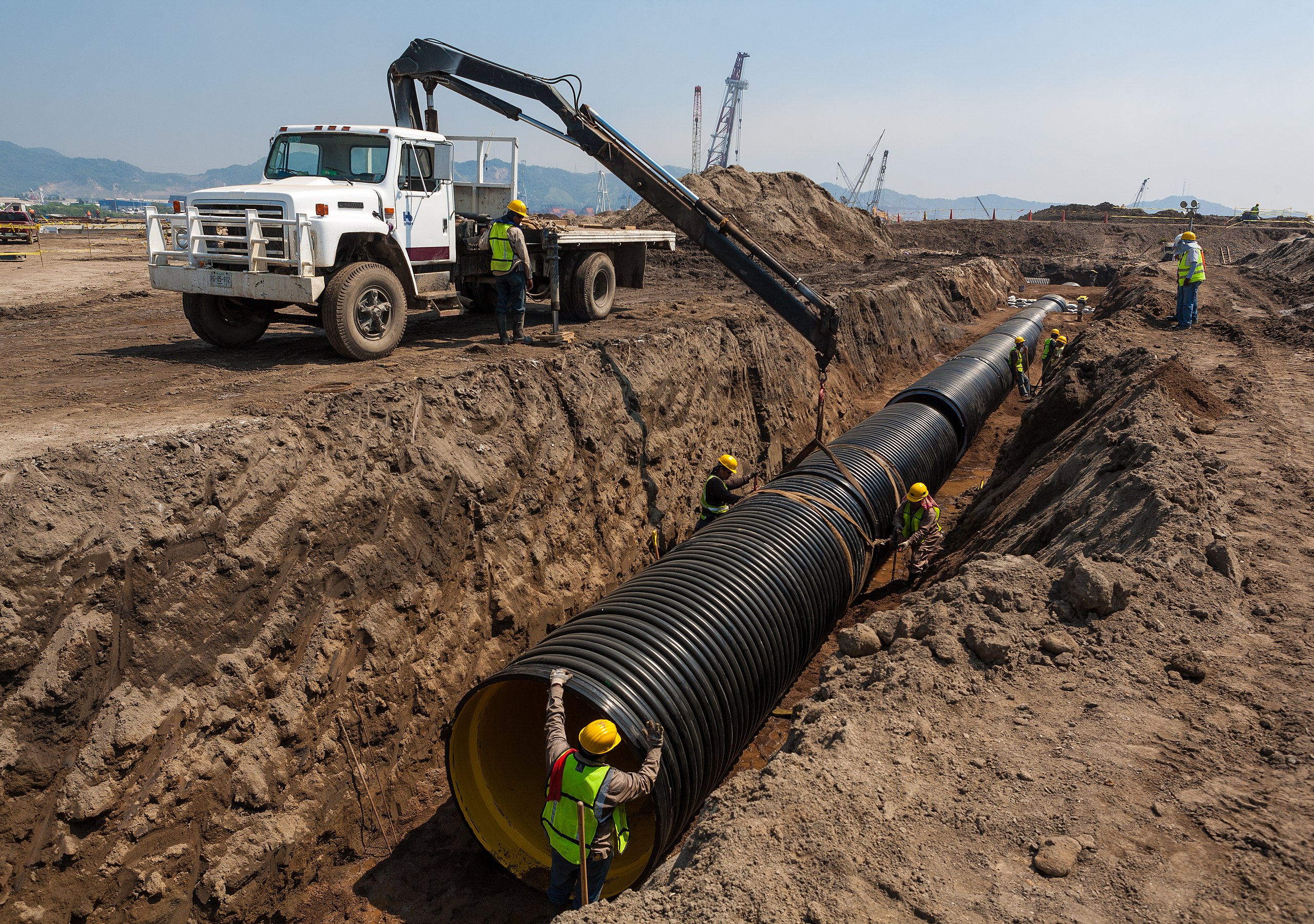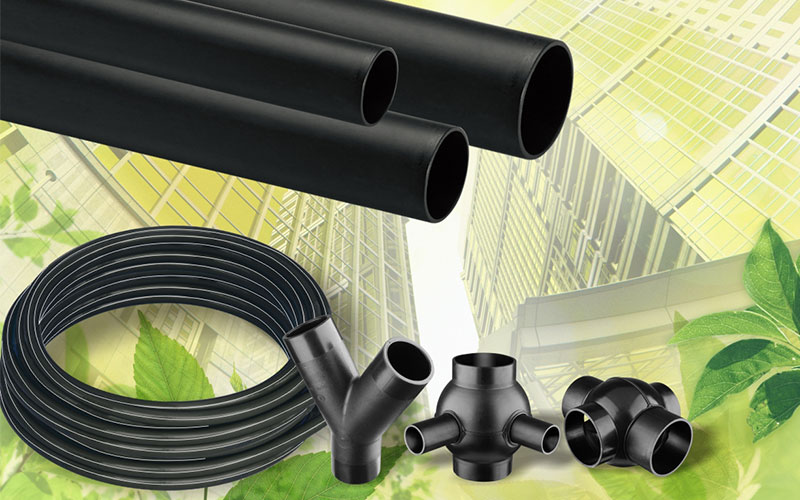Check Out the Production Process Behind High-Quality HDPE Pipe and Its Applications
The production process of top notch HDPE pipes is intricate and systematic. It begins with the selection of raw products that enhance efficiency. Following this, ethylene undergoes polymerization to form resin, which is then formed with extrusion. Quality assurance is extremely important, making sure that the end product satisfies rigorous criteria. Nevertheless, the journey of HDPE pipes doesn't end with production. Their applications throughout various sectors disclose a more comprehensive relevance worth examining.
Comprehending HDPE: Qualities and Advantages

High-density polyethylene (HDPE) is a flexible thermoplastic understood for its durability and resistance to different ecological elements. This material shows superb tensile toughness, making it suitable for requiring applications. Its low-density framework adds to a lightweight product, promoting ease of managing and setup. HDPE likewise showcases exceptional resistance to chemicals, which reduces deterioration when exposed to harsh substances.
The product's low moisture absorption better enhances its durability, making it perfect for use in pipelines and storage containers. Furthermore, HDPE is immune to ultraviolet (UV) radiation, making sure that products maintain their honesty even when exposed to sunlight. Additionally, its flexibility permits for the production of intricate forms without compromising toughness. The green nature of HDPE, commonly stemmed from recycled materials, includes to its charm, promoting lasting practices in production. Overall, these homes and advantages make HDPE a preferred selection for numerous industrial and customer applications.
Raw Product Selection for HDPE Production
The option of raw products for HDPE production is important to validate the last product fulfills the desired specs and quality requirements. High-density polyethylene (HDPE) is mostly produced from polymerized ethylene, originated from fossil gas such as gas or petroleum. The high quality of these feedstocks significantly affects the mechanical and thermal properties of the last HDPE.
Ingredients also play a substantial role in improving HDPE's performance, including antioxidants, UV stabilizers, and colorants, which boost toughness and resistance to environmental variables. The choice procedure have to take into consideration not just the chemical composition of the raw materials however also their processing attributes to ensure reliable production.
The sourcing of raw products should prioritize sustainability and compliance with environmental policies, as liable practices are essential in today's market. Eventually, careful raw product choice lays the foundation for producing premium HDPE pipes suitable for diverse applications.
The Extrusion Process: Forming HDPE Pipe
The extrusion procedure plays a vital function fit HDPE pipes, beginning with meticulous material preparation methods that guarantee perfect circulation and uniformity. Equally important is the style of the die, which straight influences the last dimensions and surface area high quality of the pipeline. With each other, these factors add significantly to the effectiveness and top quality of HDPE pipeline manufacturing.
Product Preparation Techniques
Efficient manufacturing of HDPE pipes starts with meticulous product prep work techniques, especially the extrusion procedure. During this stage, high-density polyethylene material is initial dried to remove dampness, ensuring optimal flow qualities. The resin is after that fed into the extruder, where it goes through home heating and melting, changing into a viscous state. This home heating process is thoroughly regulated to maintain the product's integrity and efficiency. The liquified HDPE is compelled through a die, shaping it right into a continuous pipe type. Proper temperature monitoring throughout extrusion is essential, as it straight influences the product's homes and the end product high quality. When formed, the HDPE pipe is cooled and reduced to specified lengths, all set for succeeding handling and applications.
Die Design Importance
Precision in die design plays a vital duty in the extrusion process of HDPE pipes. The die works as the final shaping device, directly influencing the pipe's dimensions, wall surface density, and surface finish. A well-designed die warranties uniform product circulation, reducing issues such as irregularities and weak points. The geometry of the die must be optimized to accommodate the particular residential or commercial properties of HDPE, including its thickness and thermal behavior during extrusion. In addition, the cooling price of the material as it goes through the die can substantially affect the pipe's structural stability. Spending in sophisticated die innovation is crucial for suppliers intending to generate high-grade HDPE pipes that meet industry criteria and consumer expectations.
Quality Control Procedures in HDPE Production
Although different elements influence the high quality of HDPE pipe manufacturing, reliable high quality control procedures are vital to ensure uniformity and reliability in the end product. Secret top quality control techniques include rigorous product assessment, validating that the raw polyethylene meets well established criteria for purity and density. Throughout the extrusion procedure, criteria such as temperature level, pressure, and cooling time are very closely checked to maintain dimensional accuracy and structural integrity
Additionally, post-production screening is crucial; suppliers typically conduct hydrostatic tests to analyze the pipeline's stamina and resistance to pressure. Visual evaluations for surface flaws further enhance quality control. Accreditation from pertinent criteria companies, like ASTM or ISO, provides an additional layer of reputation. By applying these complete quality assurance steps, producers can minimize defects, enhance efficiency, and make sure that the HDPE pipelines fulfill fix plumbing leak the specific demands of various applications, inevitably leading to consumer complete satisfaction and depend on in the product.
Applications of HDPE Pipeline Across Industries
HDPE pipelines are made use of across numerous sectors as a result of their durability and versatility. In water distribution systems, they guarantee effective distribution, while in wastewater administration, they give reputable solutions for waste transportation. In addition, agricultural watering networks benefit from HDPE's resistance to corrosion and flexibility, making it a perfect selection for modern farming techniques.

Water Circulation Equipments
A considerable variety of industries rely upon high-density polyethylene (HDPE) pipes for effective water distribution systems. Recognized for their sturdiness and resistance to rust, HDPE pipes are widely utilized in local water system networks, farming irrigation, and commercial applications. Their light-weight nature assists in very easy handling and installation, decreasing labor expenses and time. In addition, HDPE pipelines can fit numerous stress degrees, making them appropriate for both reduced and high-pressure systems. hdpe pipe fittings Midland TX. The flexibility of the material permits for seamless integration right into existing framework, decreasing the demand for substantial excavation. HDPE's resistance to chemical seeping warranties that the water provided continues to be risk-free and tidy, making it an ideal selection for preserving the high quality of drinkable water across various industries.
Wastewater Monitoring Solutions
Efficient water circulation systems also lead the method for innovative wastewater monitoring services, where high-density polyethylene (HDPE) pipes play a substantial duty. Distinguished for their durability and resistance to deterioration, HDPE pipelines are excellent for moving wastewater in numerous setups. Their flexibility permits for easy installment in intricate atmospheres, reducing the requirement for substantial excavation. Additionally, HDPE's smooth interior surface minimizes rubbing, boosting flow rates and effectiveness. These pipelines are likewise resistant to chemical leaching, making sure that impurities do not compromise the surrounding environment. Industries, towns, and treatment centers progressively count on HDPE pipes for their integrity and longevity, making them a preferred option for modern-day wastewater administration systems. This adaptability emphasizes the important importance of HDPE pipelines throughout countless applications.
Agricultural Irrigation Networks
Agricultural irrigation networks profit greatly from the usage of high-density polyethylene (HDPE) pipes, which offer reliable and reliable water distribution to plants. HDPE pipelines are lightweight, making them very easy to transfer and install, while their adaptability enables various setups in diverse surfaces. These pipelines show outstanding resistance to corrosion, chemicals, and UV radiation, making sure resilience in extreme farming environments. Furthermore, their smooth indoor surface area minimizes rubbing loss, maximizing water flow and decreasing power costs related to pumping. The longevity of HDPE pipes, frequently surpassing 50 years, adds to lower maintenance and replacement expenditures. Farmers significantly rely on HDPE pipes to improve watering efficiency and advertise lasting agricultural methods, ultimately leading to improved plant yields and resource conservation.

Future Fads in HDPE Pipeline Modern Technology
As the demand for sustainable and reliable facilities expands, innovations in HDPE pipe innovation are poised to change different sectors. Emerging trends include the combination of clever innovations, such as sensing units and IoT abilities, which facilitate real-time tracking of pipe problems, minimizing maintenance prices and protecting against leakages. In addition, the growth of innovative production methods, such as 3D printing, is allowing the manufacturing of facility, customized pipe styles that find more info satisfy particular job requirements.
The focus on recycling and round economic climate practices is driving the innovation of HDPE pipes made from recycled materials, enhancing sustainability. Improved jointing techniques, such as electro-fusion and mechanical installations, are also improving setup efficiency and reliability. The expanding focus on ecological policies is pushing suppliers to embrace greener manufacturing procedures, guaranteeing that HDPE pipelines not only fulfill industry requirements but additionally foster an even more lasting future for framework advancement.
Often Asked Concerns
Exactly How Does HDPE Contrast to Other Plastic Materials?
HDPE surpasses several other plastic materials regarding resilience, chemical resistance, and versatility. Its reduced density and high tensile strength make it ideal for different read the article applications, often surpassing alternatives in both performance and long life.
What Are the Ecological Impacts of HDPE Production?
The ecological influences of HDPE production include greenhouse gas emissions, power usage, and potential pollution from making procedures. Additionally, inappropriate disposal can lead to soil and water contamination, raising issues concerning long-lasting environmental results.
Can HDPE Water Lines Be Recycled?
Yes, HDPE pipes can be reused. Lots of facilities accept utilized HDPE for handling, transforming it into brand-new products. This reusing contributes to sustainability efforts, minimizing plastic waste while preserving resources and energy in the production cycle.
What Is the Life-span of HDPE Pipeline?

Just How Do Temperature Variants Impact HDPE Pipe Efficiency?
Temperature variants significantly affect HDPE pipe performance, influencing flexibility and toughness. High temperature levels can cause softening, while reduced temperature levels may create brittleness, ultimately affecting the pipeline's resilience and viability for different applications in diverse atmospheres.